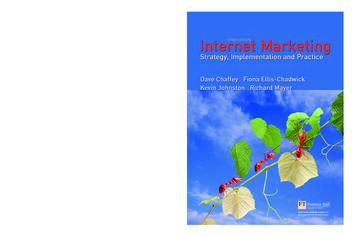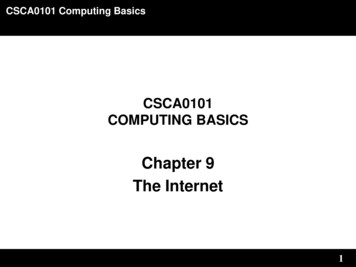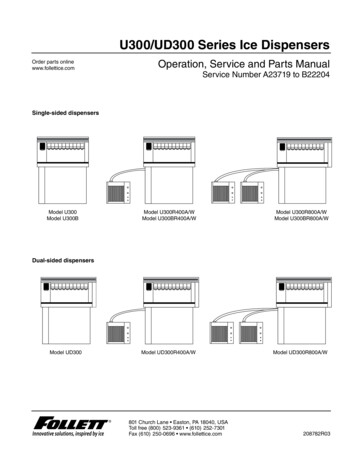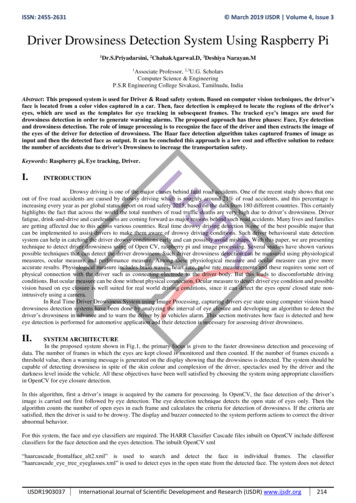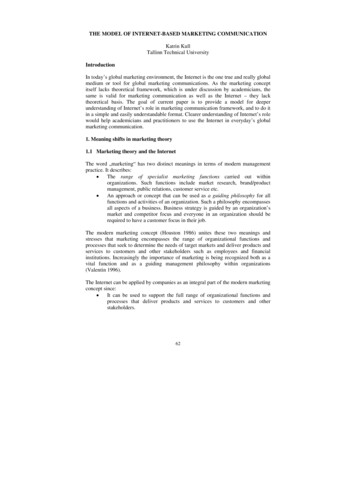
Transcription
THE MODEL OF INTERNET-BASED MARKETING COMMUNICATIONKatrin KullTallinn Technical UniversityIntroductionIn today’s global marketing environment, the Internet is the one true and really globalmedium or tool for global marketing communications. As the marketing conceptitself lacks theoretical framework, which is under discussion by academicians, thesame is valid for marketing communication as well as the Internet – they lacktheoretical basis. The goal of current paper is to provide a model for deeperunderstanding of Internet’s role in marketing communication framework, and to do itin a simple and easily understandable format. Clearer understanding of Internet’s rolewould help academicians and practitioners to use the Internet in everyday’s globalmarketing communication.1. Meaning shifts in marketing theory1.1 Marketing theory and the InternetThe word „marketing“ has two distinct meanings in terms of modern managementpractice. It describes: The range of specialist marketing functions carried out withinorganizations. Such functions include market research, brand/productmanagement, public relations, customer service etc. An approach or concept that can be used as a guiding philosophy for allfunctions and activities of an organization. Such a philosophy encompassesall aspects of a business. Business strategy is guided by an organization’smarket and competitor focus and everyone in an organization should berequired to have a customer focus in their job.The modern marketing concept (Houston 1986) unites these two meanings andstresses that marketing encompasses the range of organizational functions andprocesses that seek to determine the needs of target markets and deliver products andservices to customers and other stakeholders such as employees and financialinstitutions. Increasingly the importance of marketing is being recognized both as avital function and as a guiding management philosophy within organizations(Valentin 1996).The Internet can be applied by companies as an integral part of the modern marketingconcept since: It can be used to support the full range of organizational functions andprocesses that deliver products and services to customers and otherstakeholders.62
It is a powerful communication medium that can act as a “corporate glue”that integrates the different functional parts of the organization.It facilitates information management, which is now increasinglyrecognized as a critical marketing support tool to strategy formulation andimplementation.(Chaffey et al. 2001)During the last decade there has been a significant shift in marketing theory. Theemphasis that was on production and persuading customers to buy, is shiftingtowards creating relationships with the consumers and communicating with them.Central terms of this meaning shift are interactivity, communication andrelationships.1.2 Relationship marketingDuring last two decades of the 20th century both academicians and practitioners haverealized that company’s most valuable assets are relationships with customers andother stakeholder groups. As it costs up to nine times more to acquire a new customerthan to retain the current one (Peppers and Rogers 1993), it is clear that it pays tovalue relationships. Also profits per customer increase by the time of relationship –the more the customers stay with the company, the more willing they are to paypremium prices, make referrals, demand less and spend more. So retaining customersby building relationships makes marketing efforts more cost-effective. The conceptof relationship marketing has been proposed as a new marketing paradigm (Grönroos1990), but it has remained rather a concept because of lacking characteristics of aparadigm.The interactive, multimedia interface of the Internet provides an ideal environment inwhich to conduct the abovementioned relationship, and databases provide afoundation for storing information about the relationship and providing informationto strengthen it by leading to improved, often personalised service.Relationship marketing theory provides the conceptual underpinning of one-to-onemarketing since it emphasizes enhanced customer service through knowing thecustomer, and deals with markets segmented to the level of the individual. Directmarketing provides the tactics that deliver the marketing communication andsometimes the product itself to the individual customer. Database marketing providesthe technological enabler, allowing vast quantities of customer-related data to bestored and accessed in ways that create strategic and tactical marketing opportunities.To use the Internet for one-to-one marketing, companies need to be able to apply allthese related areas of theory.Achieving one-to-one marketing on the Internet has the well-known advantages ofrelationship marketing – that is, it is targeted and personalised, but these benefits arebuilt on in the Internet medium since it can: Target more effectively63
Increase depth, breadth and nature of relationship Lower cost(Chaffey et al. 2001)Following the evolution of marketing theory, we can see how it moved from atransaction-based approach of 4Ps model (Borden 1964; McCarthy 1964) to arelation-based approach (Grönroos 1990). Inbetween there have been suggestions andattempts to broaden the 4Ps concept (Christopher, Payne and Ballantyne 1991), butthose have all been confronted with the burdens of the concept. Waterschoot and Vanden Bulte (1992) concluded that there is a need to emphasize the relationships in themarketing model. Although they referred to relationships as “persuasion”, theyidentified Promotion from the 4Ps as a common denominator for all Ps, identifyingthus, that communication is the base for all marketing mix elements.1.3 CommunicationCommunication is the unique activity that creates relationships (Duncan andMoriarty 1998). Everything company does and does not do, sends a message. Thecommunication is also a central integrative process in marketing. It is demonstratedin evolving theories of relationship marketing and integrated marketingcommunicaton. Duncan and Moriarty (Ibid.) show the elements of intersectionbetween communication and marketing theory and come to a communication-basedmarketing model for managing relationships. They bring out the similarity of thebasic marketing model and the basic communication model (figure 1). They discusscommon theoretical roots of the theories, and even suggest (referring to Zinkham1996) that the two could be complementary metaphors.Figure 1. The similarity of basic marketing model and basic communication model(Duncan and Moriarty 1998)They develop a model that shows how communication (rather than persuasion) is thefoundation of marketing efforts (figure 2). The increase in interactivity makes64
communication the most valuable element of marketing that leads to the brandrelationships that drive brand value.Figure 2. Communication and marketing intersection model of Duncan and Moriarty(Ibid.)One of the main elements of the model is interactivity, that is considered to be one ofthe basic foundations of the communication platform together with messages andstakeholders. They move forward to a more sophisticated model (simplified version:figure 3) where they include an organizational perspective and show how theinteractivity between marketing organizations and customers and other stakeholdersleads to the brand value.Figure 3. A simplified version of the communication-based marketing model formanaging relationships by Duncan and Moriarty (1998)1.4 InteractivityThe keyword for meaning shifts in today’s and tomorrow’s marketing theory isinteractivity. It was already in 1997, at the AMA Summer Education Conference,when it was called for a new marketing model to guide marketing in the interactivefuture (Ibid.).65
Most of the textbooks and articles, dealing with different marketing areas, discussdifferent meanings and applications of the term. The word “interactivity” is usuallyused without specific definition, using its normal meaning in English language: “tointeract - to act on each other” (Webster’s Dictionary). In marketing texts,“interactive” is an adjective for showing the two-way character of the process,usually a marketing communication process. The objective of an one-waycommunication process is to effectively deliver the message. In two-waycommunication process there is an additional goal - to get feedback.According to Schramm’s (1955) definition, the feedback can be described as “thereversal of the flow, an opportunity for communicators to react quickly to signs,resulting from the signs they have put out.” Without feedback there is no dialogue.Feedback is the essence of interactivity. In marketing theory of the sixties, theamount of goods bought was considered to be the main feedback of marketingefforts, because there was no possibility to measure the feedback any other way. Intoday’s highly competitive environment, the only method for being profitable in longterm is to create long-term relationships with the customers. The basis for developingthe relationships is communication. If relationships are the objective, thecommunication must be personal and customized. Today’s media and computertechnologies enable us to measure the feedback in greater perspective and morequickly. Thus the interaction between the organization and its customer can bereached more quickly and with more effective results.At the corporate level, interaction has to work between all corporate functions. At themarketing level, the interaction takes place while forming the partnerships betweendistributors and suppliers. At the marketing communication level, the interaction isgenerated, combining one- and two-way communication (combining public relationsand advertising with personal selling and direct marketing). (Duncan and Moriarty1998)2. The Internet – a new marketing mediumInternet marketing is the application of the Internet and related digital technologies toachieve marketing objectives.Chaffey et al. (2001) bring out that there is an opportunity for Internet marketingmyopia. Internet marketing is often approached as a communication and selling tool.If Internet marketing is to become integrated and fully established as a strategicmarketing management tool, the focus needs to move towards understanding itsbroader applications within the total marketing process rather than just using ist forcommunication and selling. The use of Internet has significant implications for theway in which relationships with channel partners such as wholesalers, distributorsand retailers are managed. Extranets are often used to manage these linkageselectronically. Internet can cause disintermediation and reintermediation.66
Internet marketing differs from conventional marketing communications because ofthe two-way nature of the Internet communication. The Internet and other digitalmedia such as digital television, satellite and mobile phones enable interactivity thathas not been previously possible. But it is important to remember that in marketingcommunication framework, Internet can be described as a medium rather than aseparate marketing communication tool or a completely new field of marketing.Figure 5 shows the Internet in traditional marketing communication framework.Figure 4. The Internet in traditional marketing communication frameworkChaffey et al. (2001) have presented a number of differences between the traditionaland new media, which are shown in table 1.Table 1. Differences between new and traditional media. After Chaffey (2001)Traditional mediaOne-to-manycommunication modelNew mediaOne-to-one or many-tomanycommunicationmodelMass marketingIndividualized marketingor mass customizationMonologueDialogueSupply-side thinkingDemand-side thinkingCustomer as a targetCustomer as a partnerCommentHoffman and Novak (1996) state thattheoretically the Internet is many-tomany medium, but for company-tocustomer-organizations it is bestconsidered as one to onePersonalization possible because oftechnology to monitor preferencesand tailor content (Deighton 1996)Indicates the interactive nature of theWWW, with the facility for feedbackCustomer pull becomes moreimportantCustomer has more input intoproducts and services requiredDeighton (1996) identifies the following characteristics inherent in a digital medium: the customer initiates contact67
the customer is seeking information (pull)it is a high intensity medium – the marketer will have 100% of theindividual’s attention when he or she is viewing a web sitea company can gather and store the response of the individualindividual needs of the customer can be addressed and taken into accountin future dialoguesThe interactive nature of the medium means that the Internet is ideally suited todevelop relationships with customers. The Internet enables a one-to-one dialogue tobe held with the customer (Chaffey 2001). When linked with the techniques fromdirect and database marketing such as customer profiling, the Internet can be used tobuild long-term relationships with customers in which a company learns theirpreferences and develops specific services and products to meet these needs.An important part of Internet marketing are web sites, which are central points inorganization’s Internet presence. Hoffman and Novak (1996) analyze the Web as acommercial medium, and examine commercial web sites. They give a thoroughcategorization of web sites, dividing them into six distinctive types includinga)Online storefront, b)Internet Presence, c)Content, d)Mall, e)Incentive site, and f)Search agent. The first three comprise the Internet destination sites and the latterthree represent forms of Web traffic control. Different site types represent differentstrategies of Internet marketing. The impact of web presence on the role of marketingcommunications on the business is dependent on the stage of developing a webpresence. Table 2 lists the stages of e-commerce service development. The Contactstage is only a modest advance of print media, where the Internet is simply anadditional channel. In the Relate stage the web site is a full two-way relationshipenvironment with full integration of Internet capability onto the business.Table 2. Stages of e-commerce service development (Rowley ticsPromote corporate imagePublish corporate informationOffer contact informationEmbed information exchangeTargeted marketing effortOnline transactionsCatalogue order/fulfilmentInteraction with trading partnersTwo way customer relationshipFull integration of Internet capability into thebusinessService interface integrated with delivery andother business operationsWeb site The two-way nature of the communication in the Internet is considered to be thereason for the need to remodel the communication model of Internet environment.68
3. Remodelling marketing communications in the Internet3.1 The differences between traditional and Internet-based communicationsFigure 6 illustrates the interaction between an organization (O), communicating amessage (M) to customers (C) for a single-step flow of communication. It is apparentthat for traditional mass marketing in (I) a single message (M1) is communicated toall customers (C1 to C5). With a web site with personalization facilities (II) there is atwo-way interaction, with each communication potentially being unique.I Traditional one-to-many massmarketing communicationsII One-to-one Internet-basedcommunicationsIII Many-to-many communicationsvia the Internet mediumFigure 5. Differences between one-to-many and one-to-one communicationusing the Internet (Chaffey et al. 2001)3.2 Marketing-related approaches for modelling the communication in InternetHoffman and Novak (1997) believe that this change is significant enough to representa new model for marketing. They suggest that the facilities of the Internet includingthe World Wide Web represent a computer-mediated environment in which theinteractions are not between the sender and the receiver of information, but with themedium itself. They say: “Consumers can interact with the medium, firms canprovide content to the medium, and in the most radical departure from traditional69
marketing environments, consumers can provide commercially-oriented content tothe media”. This situation is shown on Figure 5 (III).Peters (1998) suggests that communication via the new medium is differentiatedfrom communication using traditional media in four different ways. First, communication style is changed, with immediate, or synchronoustransfer of information through online customer service being possible.Asynchronous communication, where there is a time delay betweensending and receiving information as through e-mail, also occurs. Second, social presence or the feeling that a communications exchange issociable, warm, personal and active may be lower if a standard web page isdelivered, but can be enhanced, perhaps, by a personalized e-mail. Third, the consumer has more control of contact. Finally, the user has control of content for example through personalizationfacilities.Although Hoffman and Novak (1997) point out that on the Internet the mainrelationships are not directly between sender and receiver of information, but withthe web-based environment, the classic communication model of Schramm (1955)can still be used to help understand the effectiveness of marketing communicationusing the Internet. Figure 5 shows the model applied to the Internet. Three of theelements of the model that can constrain the effectiveness of Internet marketing are: encoding – this is the design and development of the site content or e-mailthat aims to convey the message of the company, and is dependent on theunderstanding of the target audience;noise – this is the external influence that affects the quality of the message;in an Internet context this can be slow download times, the use of plug-insthat the user cannot use or confusion caused by too much information onscreen;decoding – this is the process of interpreting the message, and is dependenton the cognitive ability of the receiver, which is partly influenced by thelength of time they have used the Internet.Figure 6. The communication model of Schramm (1955) applied to the Internet(Chaffey et al. 2001)70
It is suggested by Hoffman and Novak (1996) that the key difference in Internetmarketing and traditional marketing approach is the way in which interactions occurbetween the different parties involved in the marketing process. Chaffey et al. (2001)note that their comments refer specifically to the World Wide Web, which they referto as a “global hypermedia computer-mediated environment”. Their claims will bediscussed as follows: World Wide Web as many-to-many medium. “Many-to-many medium” isthe term that refers to the potential for the Internet to provide exchange ofinformation between customers and suppliers. A many-to-manycommunication involves information being sent to many participants andimplies interaction between participants in a discussion forum or virtualcommunity. Chaffey et al. (Ibid) argue that while these tecniques are usedquite frequently in a commercial context for customer support, they cannotbe described as the predominant form of communication in the WorldWide Web. This is currently one-to-many, and involves a companycreating static information on a web site, which is accessed by manycustomers. The technique is similar to that of traditional marketing bymeans of mass media advertising. The current arrangement will change inthe future. Many sites have already set up web pages for customers toenable one-to-one communication. However, it can be argued that one-toone marketing is not a paradigm shift, but merely a method of achievingdirect marketing using a new, effective medium. The author believes that inreality we can reach the true one-to-one marketing by m-communicationand m-commerce techniques. Mobile phones are more personal and moreavailable equipment to the consumers than PCs, being portable as well ascheaper. Thus the m-audience will consist of more people and thecommunication with them will be direct or even immediate. In marketing via traditional media consumers cannot directly control themessage or easily request further information, but they can do so with theWorld Wide Web, and this represents a significant difference. It should benoted, though, that traditional media integrate different forms of media toachieve a similar effect (Chaffey 2001). This is arguably less effective thanthe web solution. Consumers can provide commercially oriented content to the World WideWeb. This is not possible with the traditional marketing communications,and it is a significant difference. Consumers can contribute to company orproduct-specific discussion forums and communities.Chaffey et al. (Ibid.) bring out that the Web is a “pull”-medium where the customerdecides which content to view. This means that companies need to use a differentapproach to marketing, in which they have to provide signposts and a large volumeof relevant information that reflects different customer needs rather than providingsmaller volumes of less targeted information.71
Hoffman and Novak go further with their approach to computer-mediatedenvironments, trying to reach the communication model for such environments. Theydiscuss the process model of network navigation in hypermedia computer-mediatedenvironments, defining the concept of flow to describe the interactive process withcomputers, and propose a process model according to the flow experience. Being asophisticated and rather academically oriented model, it lacks the real lifebackground. Thus it is difficult to use the model for understanding the businessenvironment in Internet.It is important that Hoffman and Novak bring out that the Internet is not the onlyterm to use for describing the virtual environment. The term “computer-mediatedenvironment” can be used to describe for example also m-commerce, and hopefullyother emerging forms of communication.3.3 Communication theory as acommunication process remodellingbackgroundforapproachingtheFiske (1990) brings out that there are two main schools in the study ofcommunication. The first sees communication as the transmission of messages. It isconcerned with how senders and receivers encode and decode, with how transmittersuse the channels and media of communication. It is concerned with matters likeefficiency and accuracy. It sees communication as a process by which one personaffects the behaviour or state of mind of another. If the effect is different or smallerthan that which was intended, this school tends to talk in terms of communicationfailure, and to look to the stages in the process to find out where the failure occurred.Fiske (Ibid.) refers to it as the “process” school.The second school sees communication as the production and exchange of meanings.It is concerned with how messages, or texts interact with people in order to producemeanings, so it is concerned with the role of texts in the cultural environment. It usesterms like signification, and does not consider misunderstandings to be necessarilyevidence of communication failure – they may result from cultural differencesbetween sender and receiver. For this school, the study of communication is the studyof text and culture. The main method of study is semiotics, so Fiske (Ibid.) calls it the“semiotics” school.The process school tends to draw upon the social sciences, psychology and sociologyin particular. The semiotics school tends to draw upon linguistics and arts subjects. Inmarketing communication studies the approach to communication is usually processoriented. The field of marketing communications is developing rapidly, newmediums emerge, and the framework is constantly under discussion. So the emphasisin work of both academicians and practitioners has been put on rather theeffectiveness than signification or meaning of marketing communication. Also theauthor considers the process school approach more suitable for communicationframework developing. It allows us to combine the aspects of marketing theory,communication theory and management theory in more focused manner, so that as a72
result we will gain more understanding of how the communication strategies work inreal business environment, and come closer to the currently searched “new marketingparadigm”.The basic communication model of Shannon and Weaver from 1949 presents asimple and clear linear process (Figure 7).Figure 7. The communication model of Shannon and Weaver from 1949(after Fiske 1990)They identify three levels of problems in the study of communication: Technical problems: How accurately can the symbols of communication betransmitted? Semantic problems: How precisely do the transmitted symbols convey thedesired meaning? Effectiveness problems: How effectively does the received meaning affectconduct in the desired way?The point of studying communication at each of the levels is to understand how wemay improve the accuracy and efficiency of the process.4. Remodelling Internet-based marketing communicationsGoing through previously discussed models of communication and marketing thatinclude Internet or interactivity, the following shortages appear: There are no communication models for the Internet-based communicationfocused on marketing – they describe the pure communication process. Amarketing-oriented model would additionally emphasis the goal of thecommunication process. General marketing models sometimes include thefield of interactivity, but different authors understand the word differently.It may not refer particulary to the Internet. The existing models that focus on the process description, do not bring outthe core characteristic of the term “feedback”. Usually the feedback istreated as an opposite-directed flow to the message. In generalcommunication models it is a proper approach, but when the modelsbecome more sophisticated and admit that getting the feedback is acontinuous process, the messages do not admit the fact that after gettingfeedback from the previous message, the next message should consider thefeedback and be customized according to that.73
Figure 8 describes the Internet-based marketing communication model that isdeveloped, emphasizing the marketing orientation and reflecting the messagefeedback process the way it should be treated – as a learning process.Figure 8. The model of Internet-based marketing communicationsThe marketing process has a goal – to develop a profitable relationship between thecustomer and the organization. The basis of the business process for and organizationlies on the business mission. On the other side of the organization there are thestakeholders. It is important to emphasize that the organization sends messages notjust to customers but also to the other stakeholders – investors, resellers, suppliers,employees, competitors, the media, the government etc. Duncan and Moriarty (1998)discuss the importance of identifying stakeholders as the target group for marketingand marketing communication. The customers and other stakeholders have certainexpectations that are the basis for them to decide whether they want to continue thedialogue with the organization once they have got a message from it.The Internet as a channel lies in the centre of the model, leading to the developmentof a relationship between the organization and the stakeholders. The organizationsends out different sorts of messages. It can mean buildng a web site, but also sellingvia the Internet. The stakeholders give their feedback to the organization, answeringthe web questionnaire, or even making a buy. Thus, on the basis of the feedback, theorganization and its stakeholders develop a dialogue. The feedback must be constant,without ongoing feedback there will be no dialogue. The messages of theorganization depend on the feedback to previous messages, so the message-feedbacksystem is built as an integrated flow rather than separate attempts. The internet actsas a medium for messages and feedback, being two-way interactive one-to-onemarketing and communication channel.SummaryThe reason for developing a model for Internet-based marketing communication isthe fact that the existing models do not give a sufficient overview of the Internetbased communication principles in marketing context. In current study, the authorreviews both marketing and communication theory and models to come to a model74
that has elements from communication theory as well as from marketing. The modelis clearly marketing-focused, stating that the goal of all business processes is aprofitable relationship. Important point of the model is the fact that it shows themessage-feedback system as an integrated flow, current messages being dependantfrom the feedback of previously sent messages.Fiske (1990) makes a metaphorical statement: “A model is like a map. It representsselected features of its territory: no map or model can be comprehensive”. This wellexpressed sentence hits the mark - all models highlight different features from theframework. The objective of the current paper is not to bring out the disadvantages ofexisting communication models, but rather to highlight the role of the Internet inmarketing and communication context.The new, simple and easily understandable model helps to understand the marketingand communication theory intersection and see the unique role of Internet in globalmarketing communication Borden, N. (1964) The concept of marketing mix. Journal of AdvertisingResearch, 4 (June), 2-7Chaffey, D; Mayer, R; Johnston, K; Ellis-Chadwick, F. (2001) InternetMarketing. Pearson Education, 508 p.Christopher, M; Payne, A; Ballantyne, D. (1991) Relationshipmarketing: bringing quality, customer service and marketing toget
2. The Internet - a new marketing medium Internet marketing is the application of the Internet and related digital technologies to achieve marketing objectives. Chaffey et al. (2001) bring out that there is an opportunity for Internet marketing myopia. Internet marketing is often approached as a communication and selling tool.



